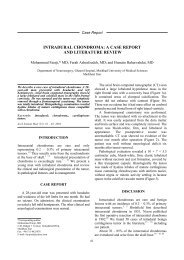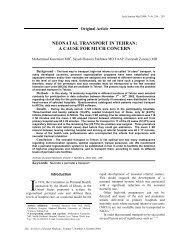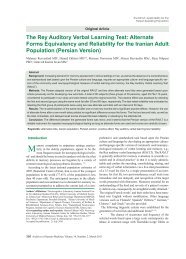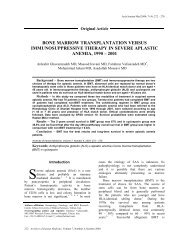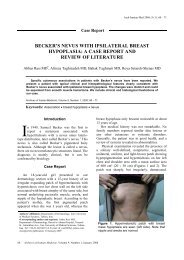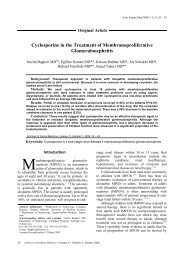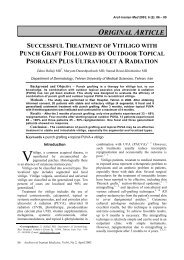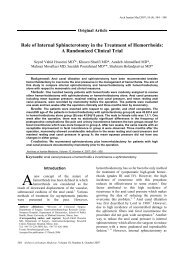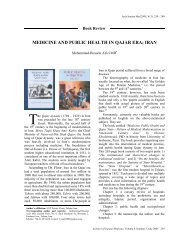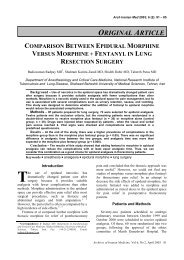Actinomycosis of the Tongue
Actinomycosis of the Tongue
Actinomycosis of the Tongue
Create successful ePaper yourself
Turn your PDF publications into a flip-book with our unique Google optimized e-Paper software.
566<br />
<strong>Actinomycosis</strong> <strong>of</strong> <strong>the</strong> <strong>Tongue</strong><br />
Archives <strong>of</strong> Iranian Medicine, Volume 11, Number 5, September 2008<br />
Arch Iranian Med 2008; 11 (5): 566 – 568<br />
Ataollah Habibi DDS MSc • *, Jahanshah Salehinejad DMD MSc**, Shadi Saghafi DMD MSc**,<br />
Ehsan Mellati DDS***, Mehdi Habibi DDS***<br />
Actinomycotic infections are known to be associated with difficulties in making <strong>the</strong> diagnosis<br />
and treatment. <strong>Actinomycosis</strong> <strong>of</strong> <strong>the</strong> tongue is rare and <strong>of</strong> great importance, not only because it<br />
can mimic many o<strong>the</strong>r diseases, but also because <strong>the</strong> tongue itself has some histophysiologic<br />
features that make it resistant to infections. In this report, we present a case <strong>of</strong> lingual<br />
actinomycosis and discuss <strong>the</strong> predisposing factors as well as <strong>the</strong> diagnostic methods and<br />
<strong>the</strong>rapeutic modalities.<br />
Archives <strong>of</strong> Iranian Medicine, Volume 11, Number 5, 2008: 566 – 568.<br />
Keywords: <strong>Actinomycosis</strong> • oral infections • tongue<br />
Introduction<br />
ctinomycosis was first described in<br />
1877, and its pathogenesis in humans<br />
was reported in 1885. It is a chronic<br />
suppurative infection mainly caused by<br />
Actinomyces israelii, although o<strong>the</strong>r types such as<br />
A. naeslundii, odontolyticus, or viscosus are found.<br />
It is a Gram- positive anaerobic bacterium that is<br />
hardly cultivable. This commensal microorganism<br />
exists independently in nature, and thus <strong>the</strong> origin<br />
<strong>of</strong> <strong>the</strong> illness is almost always endogenous. It can<br />
be isolated from <strong>the</strong> mouth, tonsil, and <strong>the</strong><br />
gastrointestinal (GI) tract; <strong>the</strong> anaerobic type<br />
which is responsible for human infection lives in<br />
<strong>the</strong> mouth. 1,2<br />
A<br />
Case Report<br />
A 54-year-old woman presented to <strong>the</strong><br />
Department <strong>of</strong> Oral and Maxill<strong>of</strong>acial Surgery <strong>of</strong><br />
Mashhad School <strong>of</strong> Dentistry complaining <strong>of</strong> a<br />
mass on <strong>the</strong> right border <strong>of</strong> her tongue which<br />
Authors’ affiliations: *Department <strong>of</strong> Oral and Maxill<strong>of</strong>acial<br />
Surgery, **Department <strong>of</strong> Oral and Maxill<strong>of</strong>acial Pathology,<br />
***Mashhad Center for Dental Research, School <strong>of</strong> Dentistry,<br />
Mashhad University <strong>of</strong> Medical Sciences, Mashhad, Iran.<br />
•Corresponding author and reprints: Ataollah Habibi DDS MSc,<br />
Department <strong>of</strong> Oral and Maxill<strong>of</strong>acial Surgery, School <strong>of</strong> Dentistry<br />
and Dental Research Center, Vakilabad Blvd., Mashhad, Iran.<br />
Tel: +98-511-882-9501, Fax:+98-511-882-9500,<br />
E-mail: dr.atahabibi@gmail.com<br />
Accepted for publication: 1 October 2007<br />
Case Report<br />
appeared following a tongue bite few months<br />
before and had recently grown. The patient’s past<br />
dental history, medical history, and family history<br />
was insignificant. Intraoral examination revealed<br />
an elevated nonulcerated and almost nontender<br />
mass covered with normal mucosa (Figure 1). No<br />
restriction <strong>of</strong> <strong>the</strong> tongue movement was found.<br />
There was no cervical lymphadenopathy and <strong>the</strong><br />
laboratory data were unremarkable. Under local<br />
analgesia, excisional biopsy <strong>of</strong> <strong>the</strong> mass was<br />
performed. The mass was 12×16 mm in diameter,<br />
well-demarcated, and relatively s<strong>of</strong>t.<br />
Histologically, a granulomatous inflammatory<br />
lesion with abscess formation including large<br />
collections <strong>of</strong> polymorphonuclear leukocytes was<br />
seen. In addition, colonies <strong>of</strong> actinomycetes<br />
Figure 1. Front view <strong>of</strong> <strong>the</strong> mass, located on <strong>the</strong> right<br />
border, in <strong>the</strong> anterior two-thirds <strong>of</strong> <strong>the</strong> tongue.
consisting <strong>of</strong> club-shaped filaments were apparent<br />
in histologic examination (Figure 2). After biopsy,<br />
treatment with intravenous penicillin was<br />
commenced and continued for three weeks. The<br />
patient was instructed and encouraged to keep a<br />
better oral hygiene and was advised to return for<br />
occasional follow-ups. Follow-up visits after one<br />
month, three months, and one year revealed no<br />
evidence <strong>of</strong> recurrence.<br />
Discussion<br />
Oral actinomycosis, although not common, is<br />
an important entity to <strong>the</strong> cervic<strong>of</strong>acial clinicians.<br />
Presenting clinical manifestations are <strong>of</strong>ten<br />
confusing because <strong>the</strong>y usually resemble o<strong>the</strong>r<br />
disease processes. 1 The usual pattern <strong>of</strong> <strong>the</strong> disease<br />
is <strong>the</strong> multiple abscess formation and <strong>the</strong> most<br />
common symptoms are swelling and hardening <strong>of</strong><br />
<strong>the</strong> s<strong>of</strong>t tissue. <strong>Actinomycosis</strong> produces a massive<br />
fibrotic reaction surrounding <strong>the</strong> necrotic center <strong>of</strong><br />
<strong>the</strong> lesion, and thus, palpation <strong>of</strong>ten reveals a<br />
swelling <strong>of</strong> woody consistency. 2 Because clinical<br />
symptoms are nonspecific, actinomycosis can be<br />
readily misdiagnosed as a tumor. Although it is<br />
mentioned in <strong>the</strong> literature that untreated actinomycosis<br />
may involve <strong>the</strong> bone in 15% <strong>of</strong> <strong>the</strong> cases<br />
with a gradual cortical erosion, 3 unfortunately,<br />
most imaging techniques do not provide a<br />
significant help in diagnosis. 2 However, <strong>the</strong>y can<br />
assist <strong>the</strong> clinician to define <strong>the</strong> lesion’s<br />
inflammatory origin and differentiate it from<br />
neoplasms. More than 50% <strong>of</strong> <strong>the</strong> patients initially<br />
Figure 2. Microscopic view demonstrating <strong>the</strong> large<br />
collections <strong>of</strong> polymorphonuclear leukocytes (PMN) as<br />
well as <strong>the</strong> bacterial colony (BC). The basophilic central<br />
core and <strong>the</strong> eosinophilic peripheral portion <strong>of</strong> <strong>the</strong><br />
colonies are also apparent (H&E, original magnification<br />
×100).<br />
A. Habibi, J. Salehinejad, S. Saghafi, et al.<br />
present with a slight hyperpyrexia, yet <strong>the</strong> presence<br />
<strong>of</strong> regional lymphadenopathy is not frequent,<br />
except in late stages <strong>of</strong> <strong>the</strong> disease. 2<br />
Lingual actinomycosis is rare, representing less<br />
than three percent <strong>of</strong> all reported cases <strong>of</strong><br />
actinomycosis. 4 In 1989, Brignall and Gilhooly<br />
published a 20-year review <strong>of</strong> <strong>the</strong> English literature<br />
and found just seven cases. 4 In 2006, Atespare et<br />
al. reported that <strong>the</strong> overall number <strong>of</strong> reported<br />
cases does not exceed 15. 5 Its rarity can be<br />
explained by <strong>the</strong> fact that <strong>the</strong> histophysiologic<br />
characteristics <strong>of</strong> <strong>the</strong> tongue make it resistant to<br />
infection. Its keratinized mucosal lining, richly<br />
vascular parenchyma, great mobility, and<br />
mechanical cleansing by saliva make it difficult for<br />
bacteria to adhere and multiply; thus, <strong>the</strong>re are<br />
very few reports <strong>of</strong> tongue abscesses. 5 <strong>Tongue</strong><br />
actinomycosis is generally located on <strong>the</strong> anterior<br />
two-thirds, lateral to <strong>the</strong> median sulcus, and<br />
presents as a moderately painful nodule set deep in<br />
<strong>the</strong> extrinsic and intrinsic muscles and poorly<br />
mobile on <strong>the</strong> adjacent planes. 6 Usually <strong>the</strong> patient<br />
is initially seen complaining <strong>of</strong> a painful tongue<br />
mass toge<strong>the</strong>r with dysphagia, while <strong>the</strong>re is a<br />
variable history <strong>of</strong> trauma. 1 However, unlike <strong>the</strong><br />
previously reported pattern, our patient had a<br />
relatively s<strong>of</strong>t and nontender mass without<br />
symptoms <strong>of</strong> dysphagia.<br />
The differential diagnosis <strong>of</strong> tongue<br />
actinomycosis includes o<strong>the</strong>r infections (e.g.,<br />
lingual abscess, nocardiosis, and botryomycosis)<br />
and neoplasms (e.g., granular cell tumor, neuroma,<br />
neurilemoma, lymphangioma, hemangioma,<br />
sarcoma, and metastatic tumors). 4,7 A presumptive<br />
diagnosis can be made based on <strong>the</strong> identification<br />
<strong>of</strong> <strong>the</strong> so-called “sulfur granules” in specimens<br />
obtained from chronic sinus tract, needle aspirates<br />
,or in biopsied tissues. 8 However, if doubt remains<br />
in <strong>the</strong> interpretation <strong>of</strong> <strong>the</strong> examined specimen, it<br />
can particularly be useful to culture <strong>the</strong> infected<br />
material on heart-brain agar or blood agar plates. 9<br />
A more reliable technique to demonstrate <strong>the</strong><br />
presence <strong>of</strong> actinomycosis using a fluorescent<br />
antibody has been described by Happonen and<br />
Viander. 10<br />
The pathogenesis <strong>of</strong> actinomycosis is not<br />
completely clear. The organism is unable to<br />
penetrate healthy tissue. To become invasive, it<br />
requires mucosal breakage to gain access to <strong>the</strong><br />
submucosal tissue. Thereafter, it destroys local<br />
tissue in a highly vascularized and anaerobic<br />
region and replaces it with granulation tissue.<br />
Lesions <strong>of</strong> <strong>the</strong> bone and s<strong>of</strong>t tissues may also show<br />
Archives <strong>of</strong> Iranian Medicine, Volume 11, Number 5, September 2008 567
multiple abscess formation which has little<br />
tendency to heal and may extend to <strong>the</strong> surface<br />
forming a sinus tract. 9 The yellowish purulent<br />
discharge from <strong>the</strong> chronic lesion may contain<br />
sulfur granules which represent colonies <strong>of</strong> <strong>the</strong><br />
bacteria. The consensus is that trauma plays an<br />
important role in most cases, initiating <strong>the</strong> portal <strong>of</strong><br />
entry for <strong>the</strong> organism. 1 We confirmed this<br />
hypo<strong>the</strong>sis, because our case reported a history <strong>of</strong> a<br />
tongue bite shortly prior to <strong>the</strong> appearance <strong>of</strong> <strong>the</strong><br />
lesion. In addition, poor oral hygiene and<br />
periodontitis may facilitate <strong>the</strong> penetration and<br />
pathogenesis <strong>of</strong> <strong>the</strong> microorganism. 11<br />
Once <strong>the</strong> diagnosis is established, treatment <strong>of</strong><br />
actinomycosis consisting <strong>of</strong> prolonged administration<br />
<strong>of</strong> antibiotics with surgical excision or incision<br />
and drainage should be commenced as soon as<br />
possible. Penicillin is still <strong>the</strong> drug <strong>of</strong> choice in <strong>the</strong><br />
treatment <strong>of</strong> nonallergic patients. O<strong>the</strong>r <strong>the</strong>rapies<br />
include administration <strong>of</strong> clindamycin, erythromycin,<br />
tetracycline, and lincomycin. 12 Sakallioglu et<br />
al. proposed administration <strong>of</strong> doxycycline for<br />
those with gingival and periodontal involvement. 11<br />
The recovery rate is approximately 90%. 13 This is<br />
because <strong>the</strong> lesions are amenable to surgery and<br />
antibiotic <strong>the</strong>rapy. However, actinomycosis can<br />
recur after months or years <strong>of</strong> apparent cure, 14 and<br />
<strong>the</strong> reason for <strong>the</strong> prolonged antibiotic <strong>the</strong>rapy is to<br />
prevent <strong>the</strong> chance <strong>of</strong> recurrence. It is <strong>the</strong>refore <strong>of</strong><br />
primary importance to follow patients.<br />
In summary, although cervic<strong>of</strong>acial actinomycosis<br />
is known to be <strong>the</strong> most common type,<br />
localized intraoral lesions occur rarely. An initial<br />
clinical examination can easily mistake <strong>the</strong> mass<br />
for a pyogenic abscess formation or benign or<br />
malignant neoplasia, and <strong>the</strong>refore, may lead to<br />
inappropriate or inadequate treatment. Due to <strong>the</strong><br />
opportunistic characteristics <strong>of</strong> <strong>the</strong> actinomycotic<br />
infection, early diagnosis should be made<br />
especially in <strong>the</strong> oral cavity to prevent <strong>the</strong><br />
hazardous spread <strong>of</strong> <strong>the</strong> disease. Hence, actino<br />
568<br />
Archives <strong>of</strong> Iranian Medicine, Volume 11, Number 5, September 2008<br />
<strong>Actinomycosis</strong> <strong>of</strong> <strong>the</strong> tongue<br />
mycosis should be included in <strong>the</strong> differential<br />
diagnosis <strong>of</strong> neoplasms and chronic suppurative<br />
and granulomatous lesions <strong>of</strong> <strong>the</strong> maxill<strong>of</strong>acial<br />
region.<br />
References<br />
1 Belmont MJ, Behar PM, Wax MK. Atypical presentation<br />
<strong>of</strong> actinomycosis. Head Neck. 1999; 21: 264 – 268.<br />
2 Palonta F, Preti G, Vione N, Cavalot AL. <strong>Actinomycosis</strong><br />
<strong>of</strong> <strong>the</strong> masseter muscle: report <strong>of</strong> a case and review <strong>of</strong> <strong>the</strong><br />
literature. J Crani<strong>of</strong>ac Surg. 2003; 14: 915 – 918.<br />
3 Mendell GL. Principles and Practice <strong>of</strong> Infectious<br />
Disease. New York: Churchill Livingstone; 1992: 170.<br />
4 Brignall ID, Gilhooly M. <strong>Actinomycosis</strong> <strong>of</strong> <strong>the</strong> tongue. A<br />
diagnostic dilemma. Br J Oral Maxill<strong>of</strong>ac Surg. 1989;<br />
27: 249 – 253.<br />
5 Atespare A, Keskin G, Ercin C, Keskin S, Camcioglu A.<br />
<strong>Actinomycosis</strong> <strong>of</strong> <strong>the</strong> tongue: a diagnostic dilemma.<br />
J Laryngol Otol 2006; 120: 681 – 683.<br />
6 Gerbino G, Bernardi M, Secco F, Sapino A, Pacchioni D.<br />
<strong>Actinomycosis</strong> <strong>of</strong> <strong>the</strong> tongue: report <strong>of</strong> two cases and<br />
review <strong>of</strong> <strong>the</strong> literature. Minerva Stomatol. 1998; 45:<br />
98 – 101.<br />
7 van der Waal I, Pindborg JJ. Diseases <strong>of</strong> <strong>the</strong> <strong>Tongue</strong>.<br />
Chicago: Quintessence Publishing; 1986: 57 – 58.<br />
8 Ficarra G, Di Lollo S, Pierleoni F, Panzoni E.<br />
<strong>Actinomycosis</strong> <strong>of</strong> <strong>the</strong> tongue: a diagnostic challenge.<br />
Head Neck. 1993; 15: 53 – 55.<br />
9 Benh<strong>of</strong>f DF. <strong>Actinomycosis</strong>: diagnostic and <strong>the</strong>rapeutic<br />
consideration and a review <strong>of</strong> 32 cases. Laryngoscope.<br />
1984; 94: 1198 – 1217.<br />
10 Happonen RP, Viander M. Comparison <strong>of</strong> fluorescent<br />
antibody technique and conventional staining methods in<br />
diagnosis <strong>of</strong> cervic<strong>of</strong>acial actinomycosis. J Oral Pathol.<br />
1982; 11: 417 – 425.<br />
11 Sakallioglu U, Acikgoz G, Kirtiloglu T, Karagoz F. Rare<br />
lesions <strong>of</strong> <strong>the</strong> oral cavity: case report <strong>of</strong> an actinomycotic<br />
lesion limited to <strong>the</strong> gingiva. J Oral Sci. 2003; 45:<br />
39 – 42.<br />
12 Martin MV. Antibiotic treatment <strong>of</strong> cervic<strong>of</strong>acial<br />
actinomycosis for patients allergic to penicillin: a clinical<br />
and in vitro study. Br J Oral Maxill<strong>of</strong>ac Surg. 1985; 23:<br />
428 – 434.<br />
13 Shaheen SQ, Ellis FG. <strong>Actinomycosis</strong> <strong>of</strong> <strong>the</strong> larynx. J R<br />
Soc Med. 1983; 76: 226 – 229.<br />
14 Peterson LJ, Ellis IE, Hupp JR, Tucker MR.<br />
Contemporary Oral and Maxill<strong>of</strong>acial Surgery. 3rd ed.<br />
St. Louis: Mosby; 1998: 428 – 429.



